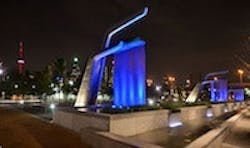Storm Water Treatment With Ultraviolet Disinfection
Located in Toronto, Ontario, Canada, Sherbourne Common is an innovative waterfront park that provides the public with green recreational space along Lake Ontario in a former industrial area. This park features three large art sculptures that rise almost 9 meters from the ground. Known as “Light Showers,” these sculptures combine water and lights to create a stunning visual piece in the park. The water then flows through an artificial river accessible to the public before discharge into Lake Ontario.
Environmental sustainability was an important element in the design of the waterfront park. Water used in the art sculptures comes from either Lake Ontario or from storm water collected at the park. Storm water runoff is stored in underground tanks that allow the sedimentation of suspended solids. The clarified runoff is then sent for disinfection before exiting the water features.
Because the water features are accessible to the public, the water must be disinfected in order to make it suitable for human contact. Historically, a limit of 100 CFU/100mL of E.coli has been adopted for safe swimming in Lake Ontario. However, the design limit for this project was 10 CFU/100 mL of E.coli in order to meet guidelines that were developed in Australia for the harvesting and reuse of storm water (NWQMS Australian Guidelines for Water Recycling: Storm Water Harvesting and Reuse). This is especially important because the area is susceptible to combined sewer overflow (CSO) events during periods of intense rainfall, which can increase the potential for microbial contamination in the park’s water supply.
In order to meet the disinfection criteria for this project, ultraviolet (UV) disinfection was selected as the preferred process. With UV, no chemicals are used, which eliminates the formation of disinfection byproducts typically formed through chlorination. UV has the added benefit of inactivating chlorine-resistant protozoa—like Cryptosporidium and Giardia—that are regulated to low limits. This is Canada’s first installation of UV for a neighborhood-wide storm water treatment system.
The Solution
In the summer of 2011, Trojan installed two TrojanUVFit reactors at the Sherbourne Common storm water treatment facility located in the basement of the park’s pavilion. Each unit can operate at a flow rate of 70 L/s, allowing for 100% redundancy. Space has been allocated for future expansion to allow installation of an additional reactor for ultimate treatment of 140 L/s (with 50% redundancy). The TrojanUVFit offers an effective and energy-efficient closed-vessel UV solution. This compact reactor is available in multiple configurations to treat a wide range of flow rates. The streamlined hydraulic profile of closed-vessel systems disinfects effluent without breaking head in the treatment process.
These benefits, along with UV’s ability to provide environmentally friendly, chemical-free treatment for chlorine-resistant microorganisms made the TrojanUVFit an attractive option for this application.
Each TrojanUVFit reactor features an automatic wiping system to minimize quartz sleeve fouling. This feature maximizes the UV output from the lamps and along with automatic dimming capabilities, reduces overall power consumption.
Another key requirement for this project was the demonstrated performance of the UV system. The TrojanUVFit reactors have all undergone bioassay validation testing in accordance to the Ultraviolet Disinfection Guidelines for Drinking Water and Water Reuse (NWRI/AwwaRF, May 2003). This third-party testing confirms the reactors as sized to meet the project’s disinfection limits will perform consistently under real-world conditions. Unlike other UV systems that rely on theoretical sizing predictions, TrojanUVFit systems were validated over a wide range of flow rates and UVT’s. This allows for accurate and reliable sizing based on empirical data, which is critical in reuse and storm water applications.
TrojanUV can be reached at [email protected] or 888.220.6118.
